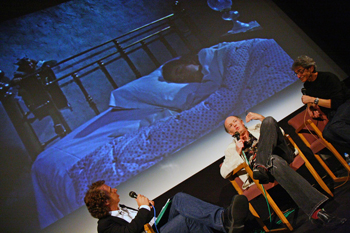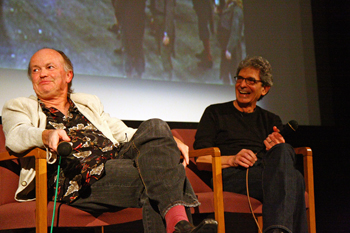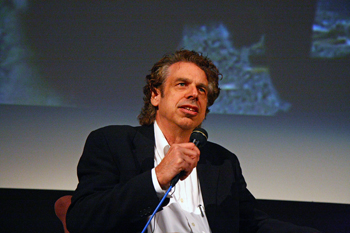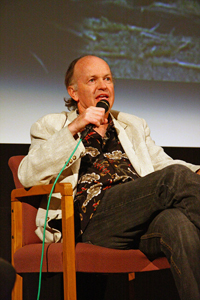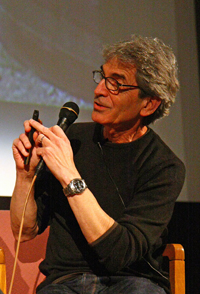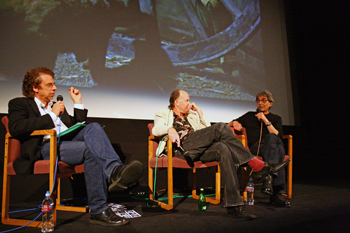 |
|
|
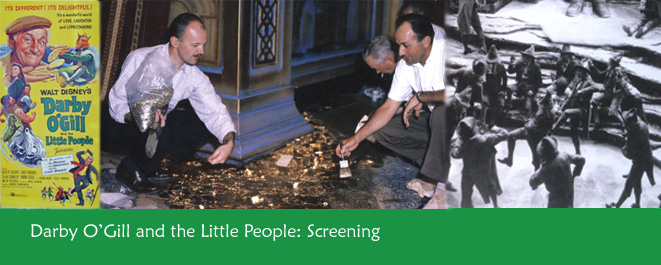
Walt Disney's
Studio is best known for animation. What a lot of Disney
fans might not know is that the studio, especially
during Walt's day, was one of the premiere visual
effects houses in the film industry.
"Mary Poppins" rightly receives a lot of praise for its
ingenious blend of animation, live action and visual
effects. Before Mary flew onto movie screens in 1964,
the Disney studio produced a charming visual effects
spectacular that has audiences stumped on "how'd they do
that?" today. "Darby O'Gill
and the Little People" was released in 1959 and
though it wasn't a tremendously successful film for the
studio, it has many admirers.
A rare screening of "Darby" was held at the Aero Theater
in Santa Monica, CA on October 26, 2008. The Art
Director's Guild sponsored the event which was moderated
by production designer John Muto. Visual effects
supervisors Harrison Ellenshaw ("TRON") and Mike Fink
("The Golden Compass") were invited to share their
memories and expertise on "Darby."
Ellenshaw's father, Peter, was the visual effects
supervisor on the film. Peter had already made his
talent known on many of Disney's live action films
including "20,000 Leagues Under the Sea" (1954). Harrison was quick to point out
that his father was a man of many talents. He's perhaps
best known for his extraordinary matte painting. But the
elder Ellenshaw was also very talented in visual effects
magic.
Harrison mentioned that moviemakers in that era could be
talented in numerous fields. To paraphrase, "Today a director walks on the
set and doesn't know about cameras, lenses or how to
work with a visual effects team. When my father worked
at the Disney Studio, many of the artists didn't just
paint. They could shoot photographs. They knew how film
emulsions were affected by light and lenses. They knew
how to compose and stage a scene. Today, a
director says he wants a spectacular visual effects. He
says this
without knowing how that's going to cause the visual
effects department many expensive headaches!"
Almost anything is possible to do in visual effects
today. Both Ellenshaw and Fink emphasized, however, that
digital visual effects can be done with too much detail.
Visual effects, if not used in service of the story, can
overwhelm a movie. They also noted that some of the most
elaborate looking effects in movies made prior to the
digital revolution were actually simple in concept.
Sometimes simpler is better and more effective on how
audiences respond to visual effects.
"Darby" is a film that's old fashioned in its honesty
and charm. This film is perhaps overlooked by Disney
fans, but it's a shame if it is. I had seen bits and
pieces of the film, but never in its entirety. My loss,
because this is one of Walt Disney's best. Seeing it on
the big screen with an audience showed how charming this
film was.
Veteran actor Albert Steele plays Darby O'Gill, an old
man who tells what are seemingly tall tales to the
townsfolk. He tells them stories of leprechauns and
their gold. One night, he follows his horse to the
castle ruins and falls into the leprechaun's kingdom
underground. This sets up a scene filled with visual
effects that still fools the eye. This is an amazing
scene that incorporates a number of visual effects,
including trick photography, miniatures, gigantic props
and matte shots. What I find so fascinating about
Disney's magic here is that I believed that O'Gill
mingled with leprechauns!
The movie might not be everyone's cup-of-tea today. It's
old-fashioned in style, yet once you get past the first
15-minutes or so, it's quite charming. Most of the cast
is very good. It was a little difficult getting past
seeing a young Sean Connery as someone other than James
Bond. One almost expects Connery, who sings in the
movie, to break out one of his top secret gadgets to
thwart Pony Sugrue (Kieron Moore)!
If you've never seen "Darby O'Gill and the Little
People," buy the DVD. Before you know it, you're
entranced by the innocence of the story, and those
amazing visual effects by Peter Ellenshaw and Eustace
Lycett. If expert visual effects supervisors like
Harrison Ellenshaw and Mike Fink can't quite figure out
some of the effects magic in "Darby," then audiences of
today will be even more stumped. Or to say it another
way, just sit back and enjoy the movie. Never mind how
they did it!
Bill Kallay
Special thanks to Harrison Ellenshaw, Mike Fink, Mike
Ellenshaw and the
American Cinematheque
Photos: © William Kallay. All rights reserved.
Photos of "Darby O'Gill and the Little People:" ©
Disney. All rights reserved.
| Photo Gallery | ||||||||||||
|
